Why you should use Online Employee Scheduling Software
19 Dec, 2013 | Tags: bar scheduling software, Employee Schedule, Employee schedule calendar, employee schedule template, Employee Schedules, Employee Scheduling, employee scheduling programs, Employee Scheduling Software, hospital schedules, hospital scheduling software, hospitality scheduling software, hotel scheduling software
Our new digital world is bringing us new, more efficient ways to complete jobs that were once thought of as time consuming, and until now inefficient. We have phones and/or tablets that are basically computers that fit in your hand. Every day there are 300 new apps created to help improve our lives. You probably use many of these each day, playing games, checking email, checking your favorite social media sites all the way down to seeing what your dog is doing all day while you are at work. However with all these programs you have to download the app. With the growth of the “cloud” (internet) companies are finding ways for you to use their software without the hassle of downloading programs. The advantages are being able to access the program and information from anywhere at any time, automatic access to any upgrades to the program and ensuring that your information will not be lost if something happens to your computer.
Today you can leverage the power of the cloud to complete your weekly work schedules with advanced yet easy-to-use What Time Do I Work online scheduling software. Here’s how it works.
- Load all the pertinent information about all your workers—names, emails, phone numbers, preferred shifts, time-off requests, hours/week, skill sets, etc.
- Employees are able to enter their own time off requests that are logged and stored in the program for the next time you begin to work on your next schedule.
- Create weekly work schedules from your office or at home.
- The software will alert you to conflicts, such as scheduling a worker in a timeslot he/she requested off or if you have accidently scheduled one employee for overtime (saving you time and money).
- When the schedule is complete, click Save, and the schedule is automatically stored in a secure cloud environment, where your employees can access it from anywhere at any time.
- Click Send, and the schedule is automatically distributed to your employees’ email addresses and/or cell phones. No more paper schedules required and no need for employees to call and ask “What time do I work?”
- Easily contact your entire staff when you have an open shift, without having to call down a phone tree
Cloud-based scheduling is faster, more efficient, and best of all, it removes you from the emergency-schedule-changing equation. Your workers can “self-serve” using the cloud.
What Time Do I Work.com taps into the strength of the cloud to deliver a solution that not only stores your schedules, but also makes them available to your employees 24×7. The What Time Do I Work.com online scheduling software offers many time saving features to aid in the schedule creation process, while also improving your business and your bottom line. Some of the top features include:
- Notifies your staff immediately when new or updated schedules are posted
- Automatically alerts you about scheduling conflicts and overtime hours
- Saves old schedules for reuse when creating new schedules based on the history of the needs of the business
- Stores time-off requests in the system; your employees enter the requests, so there’s no work for you
- Reduces “no-shows” by automatically alerting your staff of upcoming hours
To discover for yourself just how much time and energy you can save by using our online employee scheduling software, watch the video.
How do you create a Time-off Policy
17 Dec, 2013 | Tags: bar scheduling software, conflict free schedules, Employee Schedule, Employee schedule calendar, employee schedule template, Employee Schedules, Employee Scheduling, employee scheduling programs, Employee Scheduling Software, hospital scheduling software, hotel scheduling software, job schedule, Job scheduling, Job Scheduling Software, Medical Scheduling, Medical Scheduling Software, online employee scheduling software, Online Restaurant Scheduling Software, online scheduling program, restaurant schedules, restaurant scheduling software, Retail Scheduling, Scheduling Software, Scheduling tools, Staff Scheduling, Staff Scheduling Software, What Time do I Work, Whattimedoiwork.com, Work Scheduling, Workforce Scheduling
For many companies, managing vacation and time-off requests is a constant challenge. You need to maintain adequate business coverage and support while understanding that your employees have times when they need to take time off. The outcome of not having a formal policy in place about when and how to submit requests results in employees asking for time off by:
- Talking to you in the hallway or your office
- Calling you on the phone
- Sending you an email
- Scribbling the days and dates on a piece of paper and dropping it on your desk
- Taping a note to your office door
These types of requests are not only hard to deal with on the fly, becasue of the no boundaries on “acceptable ways to request time off,” but you are also tasked with trying to keep track of who requested what time off. And if you have two employees requesting the same days off, who gets first dibs?
There are many different options and ways to create policies, but the most common in the service and health industries is to create a “time-off bank.” Here’s how the bank works. Let’s say each employee is allowed 160 hours off each year, which equates to 20 work days. The bank includes time off for:
- Holidays
- Vacation
- Sick days
- Personal days
You can’t always give all your employees all of the holidays off, so they can use their banked time to request vacations or personal/sick days off. Each employee is responsible for scheduling the days he or she wants off from work, using a single prescribed method, within the needs of the business. You can require that requests are submitted for planned time off within 2 weeks of the date, and that they must submit requests on special forms that are filed away for you to refer to when creating upcoming schedules
This plan offers many benefits to employees. They can:
- Ensure that their time off request will not be forgotten
- Assume responsibility for their own time off; they make their own choices, and they need to abide by them. For example, some employees might prefer a day off for religious holidays, rather than the Fourth of July.
- Draw from their time-off bank for emergencies, such as caring for a sick child. Remember, the bank is for all time off—holidays, vacation, sick days, and personal days.
The plan also offers many benefits to you. You will:
- Spend significantly less time managing time-off requests; all requests will come to you through the standard form submitted in the “time-off request box”
- Create more accurate schedules that require fewer changes, as you no longer have to try to remember who asked for what time off?
- Empower your employees by letting them make more choices about how they spend their time away from work
- Create a more positive working atmosphere at your company
All of these ways are great, but they are still time consuming, especially when going through all the requests each time you make the schedule. Wouldn’t it be nice if you had a way for the requests to be waiting for you right on the schedule? How about knowing when each request was submitted so that you can grant requests in a first come first serve method? The solution is available today from WhatTimeDoIWork.com and there are many other benefits far beyond tracking time-off requests and auto-populating them right into the schedule.
- Automatic alerts to scheduling conflicts and overtime hours
- Calculation of Labor costs as the schedule is created
- Posting of the Schedule online allowing employees easy access without picking up the phone
- Communications sent to your entire staff as soon as a new schedule is posted.
We are so sure that our software will solve your scheduling needs that we offer the first 30 days at no charge, with no obligation.
Learn more here.
Tracking and Scheduling an Evolving Staff
12 Dec, 2013 | Tags: conflict free schedules, Employee Schedule, Employee schedule calendar, Employee Scheduling, Employees Schedules, hospital scheduling software, job schedule, Job scheduling, Job Scheduling Software, Medical Scheduling, Medical Scheduling Software, online employee scheduling software, Online Scheduler, online scheduling program, Online Scheduling Software, Retail Scheduling, Scheduling staff members, Shift Scheduling, Whattimedoiwork.com, Work Scheduling, workscheduling

Regardless of your industry—retail, hospitality, healthcare—the most important asset is your employees. Once you find good people, train them, and consider them part of your team, you want to keep them on-staff for the long term.
The reality of the situation is that “change happens.” Workers go back to school, start a family, move to a new city or state, suffer an injury, or choose to start a new career. Regardless of the reason, you have to deal with an ever-changing employee roster, and that makes tracking employee information and creating weekly work schedules challenging.
If you use traditional paper-and-pencil methods, adding/deleting/changing employee information and creating work schedules is a time-consuming task. You must update contact information, preferred hours, time-off requests and rates of pay. You must adjust vacation schedules and holiday coverage to accommodate old and new workers. The bottom line—you have a lot of work to do every time a current employee leaves and a new hire arrives.
There is a better way—one that allows you to throw away your paper-and-pencil records and schedules, It’s called online scheduling software, and it’s available today from What Time Do I Work.com.
By storing all information in a secure cloud, What Time Do I Work software makes it quick and easy to add, delete, and update employee information. You also benefit from 24×7 access to everything you need to create schedules—names, preferred shifts, time off requests, hours/week, etc. Best of all you can run reports to track each employee’s:
- Hours worked per week/month
- Rate of pay
- Department
- Vacation time
- Sick time
- Emergency time off
- Overtime
- Current Contact Information
You can use our advanced yet easy-to-use software to create a clear and accurate picture of each employee’s work history. This type of information is very valuable when it’s time for giving raises or promotions, providing extra hours or time off.
To discover for yourself just how much time and energy you can save by using our web scheduling software, you can test drive it for free. There’s no obligation, and no credit card is required to sign up. For complete information on our web scheduling software, please visit https://www.whattimedoiwork.com/features/.
What are the benefits of Online Employee Scheduling Software vs. the Traditional Methods?
05 Dec, 2013 | Tags: bar scheduling software, conflict free schedules, Employee Schedule, Employee schedule calendar, employee schedule template, Employee Scheduling, Employee Scheduling Software, hospital schedules, How do I create Conflict free schedules, job schedule, Job Scheduling Software, online employee scheduling software, online schedule, Online Scheduling, restaurant schedules, restaurant scheduling software, Schedule, schedule program, Schedules, Scheduling, scheduling best practices, Scheduling Programs, Scheduling Software, Scheduling tools, Staff Scheduling, staff scheduling softrware, web based scheduling software, Web Scheduling Software, What is the best online scheduling software, Why do I need Online scheduling software, Work Scheduler, Work Scheduling, Workforce Scheduling
Mr. Kennedy owns a midsize company called Kennedy Linens2Go, which supplies linens to hospitality businesses in the Boston, Massachusetts, area. The company operates a fleet of trucks that picks up dirty linens and drops off clean ones on a regularly scheduled basis. The principle staff members at Kennedy Linens2Go include truck drivers and linen washers.
During the majority of the year, scheduling the drivers and washers is a relatively quick and easy task. Workers have their preferred hours and shifts, and there are relatively few requests for time off. But in the summertime, workers want time off for vacations at the beach, to travel, and to spend time with their kids. Then during the holidays, people request time off to shop and attend special functions and spend time with friends and family. During these times of the year, Mr. Kennedy spends many hours each week preparing the weekly employee work schedules.
For Mr. Kennedy, creating an employee schedule for a typical pre-holiday week means:
- Accepting time-off requests from the staff via the phone, in his office, notes left on his desk or passing by in the hallway
- Creating a schedule based upon what Mr. Kennedy thought were all the requests
- Getting three last-minute requests from workers who forgot that Monday was the day to submit time-off requests
- Throwing away the original schedule and starting over again
- Finishing the second schedule, only to find that he forgot to include two part-time drivers
- Starting again on schedule number three
- Finally posting the schedule in the employee lunch room only to have one employee complain that they cannot work their scheduled shift after half of the employees have already seen the weekly schedule
- Once again he must start over for draft 4, and then contact all his employees to inform them that a new schedule is available
After two months of pre-holiday scheduling frustration, Mr. Kennedy needs some time off himself.
Rather than a vacation, Mr. Kennedy needs a new way to create weekly employee schedules. He needs a method that is quick and easy during every week of the year, even during the holidays. He also needs a much more efficient way to notify his employees of newly posted shifts and to avoid spending hours on the phone giving each of his employees their upcoming schedule, when they are not working. He needs to stop working in his business and start spending time on his business.
Luckily the perfect solution is available today from WhatTimeDoIWork.com. By offering, simple, flexible, realistic, easy-to-use online employee scheduling software, WhatTimeDoIWork.com enables Mr. Kennedy to store all his employees’ names, departments, skillsets, emails, phone numbers, preferred shifts, and requested time off in one online location. With point-and-click simplicity, Mr. Kennedy can create an employee schedule in minutes. And because all time-off and shift requests are stored in the software, Mr. Kennedy receives an alert when a scheduling conflict appears—such as trying to schedule a part-time driver on a day when she doesn’t work. Schedule changes are just as easy—Mr. Kennedy can simply cut-and-paste a time slot to a new name. Even better, all new schedules and changes are distributed to all staff members via email or smart phone, and remain accessible online to the entire staff 24×7. No more calling his entire staff not only when a new schedule is posted, but if there are any updates to the schedule.
Mr. Kennedy will find numerous benefits from online scheduling software:
- No more keeping notes of when employees want time off
- Ability to manage/update/change a schedule at any time
- No-shows are reduced; schedules are always available to the entire staff, so they all know their shifts
- No more paper schedules are required
- Employees can find their own replacements to cover in an emergency—removing Mr. Kennedy from the equation
- Automatic alerts of overtime hours or scheduling conflicts while creating the original employee schedule, which will cut down labor costs
- View labor dollars as the schedule is created
- Remind employees of upcoming shifts to eliminate no shows
To sign up for online employee scheduling software, Mr. Kennedy can simply visit https://www.whattimedoiwork.com/free-trial/. He can discover for himself how much time, effort, and frustration he’ll save by moving his employee work schedules online.
Try it out today with our 30 day no obligation free trial. And when we say free we mean free:
- No credit card is necessary to try the software
- No service contracts or hidden fees
- No downloads required
How can you make medical on call scheduling more efficient?
21 Nov, 2013 | Tags: Employee Schedule, Employee schedule calendar, Employee Scheduling, Employee Scheduling Software, hospital scheduling software, job schedule, Job scheduling, Job Scheduling Software, Medical Scheduling, online employee scheduling software, online schedule, Online Scheduler, Online Scheduling, online scheduling program, Schedule, Schedules, Scheduling, Scheduling Programs, Scheduling Software, Scheduling tools, Shift Scheduling, Staff Sche, Staff Scheduling, Staff Scheduling Software, Web Scheduling Software, What Time do I Work, Whattimedoiwork.com, wor, Work Scheduler, Work Scheduling, Work scheduling software, Workforce Scheduling
For every industry sector, effective communications are key elements of success. But for organizations that operate in the healthcare industry, clear and timely communications are critical to the well-being of not only staff members, but also patients. One type of internal communication that has historically held considerable room for improvement is on-call scheduling. Managing on-call coverage in all departments all the time can be confusing, to say the least. Normal day-to-day scheduling is simple by comparison.
Let’s assume you completed your on-call schedule for November 4, 2013. You assigned general physicians, nurses, anesthesiologists, surgeons, radiologists as your on-call staff from 11 p.m. to 7 a.m. You used a spreadsheet to create the schedule, and you posted it in the staff lounge. As far as you’re concerned, all the bases are covered, and your job it done.
Now let’s assume that your facility faces a flu epidemic, and it’s affecting not only your patients, but also your staff—including your on-call people. With a steady intake of new patients, you need a full complement of staff members on the floor. As the scheduling manager, it’s your job to find people to fill in for those who are sick. This means calling people, one by one, department by department, until you find the coverage you need. And knowing the flu spreads like wildfire, you can look forward to the exact same crisis tomorrow.
This scenario is rather drastic, but it clearly shows that it’s time for a change—one that removes the frustration and stress from on-call scheduling. You can make the change today—by replacing your traditional manual scheduling process with online scheduling software. By storing all medical staff members’ contact information, department, availability, and previous schedules in the cloud, you can quickly and easily create on-call schedules that work for your employees and your company. And you can start using it today, by visiting WhatTimeDoIWork.com.
One of the primary benefits of on-call scheduling with WhatTimeDoIWork.com is enabling all staff members to see the schedule all the time. This way, staff members can take control of their working hours. They can own the responsibility of finding a replacement for their on-call hours in case of illness, emergency, or other unforeseen problems. And for those staff members looking to pick up extra hours, the software enables off-schedule workers to contact on-call employees and ask to pick up a shift.
The beauty of the entire system is that you are removed from the equation—all changes happen in the cloud, are distributed to all staff members via email or smart phone, and remain accessible to your entire staff 24×7.
Here’s what you do:
To sign up now for online employee scheduling software visit our website and discover for yourself how much time, effort, and frustration you can save by moving your weekly and on-call scheduling to the cloud.







